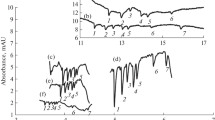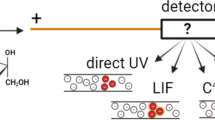Summary
A simple method for separating and detecting glucose and fructose is described. Merely heating the chromatogram under an IR radiator, or on a hotplate or in a drying cabinet, renders components separated on HPTLC plates NH2 visible under UV light.
The detection limits are similar to those obtained with spray reagents and dipping techniques. Possible application of the method to other carbohydrates is briefly mentioned.
Similar content being viewed by others
References
R. Klaus, J. Ripphahn, J. Chromatogr.244, 99 (1982).
R. Klaus, W. Fischer, Chromatographia23, 137 (1987).
W. Jost, H. E. Hauck, J. Chromatogr.261, 235 (1983).
W. Jost, H. E. Hauck, Anal. Biochem.135, 120 (1983).
W. Funk, F. Gilles, S. Netz, K. Patzsch, Merck Spectrum 3/88, 34 (1988).
K. Patzsch, S. Netz, W. Funk, J. Planar Chromatogr.1, 39 (1988).
R. I. Rieder, R. E. Kaiser, J. Planar Chromatogr.2, 62 (1989).
Author information
Authors and Affiliations
Rights and permissions
About this article
Cite this article
Klaus, R., Fischer, W. & Hauck, H.E. Use of a new adsorbent in the separation and detection of glucose and fructose by HPTLC. Chromatographia 28, 364–366 (1989). https://doi.org/10.1007/BF02261015
Received:
Accepted:
Issue Date:
DOI: https://doi.org/10.1007/BF02261015




